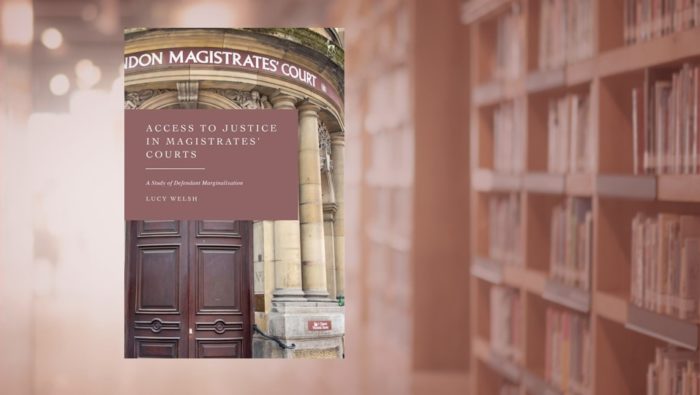
A Magistracy without Majesty

Lucy Welsh’s Access to Justice in Magistrates’ Courts perhaps epitomises the foundational commitment within Socio-Legal Studies to the margins, the overlooked, and the perennial problems of law in society. Revisiting a classic topos of the discipline, the criminal courts of first instance, Welsh eschews the more glamorous mise-en-scène of the higher courts (and the affliction of ‘appellate-court-itis’ as Jerome Frank put it) to focus on the supposedly banal quotidian. As such, Welsh joins a venerable tradition of Socio-Legal luminaries who have sought to show us in this way how law really works: Carlen, Bottoms and McClean, McBarnet, Bankowski, Hutton, and McManus, Rock, and others. Nevertheless, standing on the shoulders of giants is not without difficulties. After the pioneers have passed, and trails have been blazed, where do the next generation’s explorers go?
Two directions immediately present themselves: to return and reassess old ground after time’s passage, or to look for previously unexplored worlds of detail at a more granular level. Welsh travels down both roads. Firstly, revisiting themes of access to justice, legal aid, and representation – as Carlen and McBarnet did – but in light of the monumental political and policy shifts in the years since. Secondly, the author breaks new ground on the contemporary effects of neoliberalism, and the professionalisation of the Magistrates’ (p.100-106), upon the functioning of the Court.
Commencing with an exploration of defendant participation, Welsh formulates a thick concept of access to justice before, in Chapter 2, turning to the political and socio-economic contexts of neoliberalism’s rise in the UK. This journey from ‘greed is good’, to ‘things can only get better’, to austerity (or things cannot possibly get worse), is argued to have had particular impacts upon the funding and administration of criminal justice. Indeed, throughout the book, the eternal efficiency drive – to do more with less – is shown to have had repercussions at every level of the system. Subsequent governments’ failure to recognise that not all public services can be run as businesses has instilled an ethos of perpetual belt-tightening which, at a policy level, has produced a slew of cost and time-saving initiatives, policies, and procedural amendments, from government agencies, the legal aid board, and the Courts and Tribunal Service (Chapter 5).
Welsh’s portrait is one, in part, of a Court wracked by expeditiousness and managerialism. The conveyor belt of cases does not stop, and consequently summary criminal justice has become a homogenised, ‘one-size-fits-none’ product: ‘McJustice’. For lawyers, defence solicitors particularly, the pressures are immense. The unintended consequences, and perverse incentives, generated by neoliberal forces have likely contributed to the hollowing-out of the legal aid criminal defence sector – the evisceration of high street firms and the immiseration of those that remain.
Being both practitioner and academic, therefore, Welsh occupies an interesting position as a researcher – and over a few pages she elucidates a sensitive reflexivity to the methodological and ethical tensions this research presented (p.24-28). This includes succinct reflections upon positionality (something that can all too easily devolve into navel-gazing or self-flagellation) and intriguing observations about the promises and limitations of insider/outsider research, specifically of occupying the liminal position between practice and academy. Of course, there are those who argue the insider/outsider distinction as binary to be a false dichotomy, and others who embrace the ‘space between’. Welsh, cognisant of the ‘hermeneutic tradition’ (p.21), operates from such a viewpoint, one between the ‘internal’ and ‘extreme external’.
Insider/outsider dynamics, naturally, reverberate throughout the research process. From design, methods, and access, onto interpretation, potential bias, and analysis, all may be shaped by the experiences of the researcher previously acquired as insider. Phenomena experienced as an insider may even lead to one becoming an outsider. But remaining a ‘trusted face’ in those courts (p.20-1), reveals the importance not of how one views oneself, but rather of how one is viewed – for in a sense, identity is an exogenously imposed perception rather than an endogenous value. And respondents who are former colleagues are not just participants but ‘friends’ and ‘learned friends’.
Welsh’s fieldwork, courtroom observation and semi-structured interviews with prosecutors and defence solicitors (p.19-20), is research at an intimate scale, for intricate relationships. Access to Justice’s most notable contribution comes here, in its nuanced findings about the cooperative nature of the Magistrates’ Court workgroup and the factors impacting upon it (Chapter 3). Although the absence of zealous adversarialism in professional networks has been noted since Blumberg, the granularity of Welsh’s inquiry produces a subtler account showing both compromise and resistance from the embattled defence. And so, whilst the thread of defendant marginalisation is not always foremost throughout the book, there is much of depth and detail for any reader.

